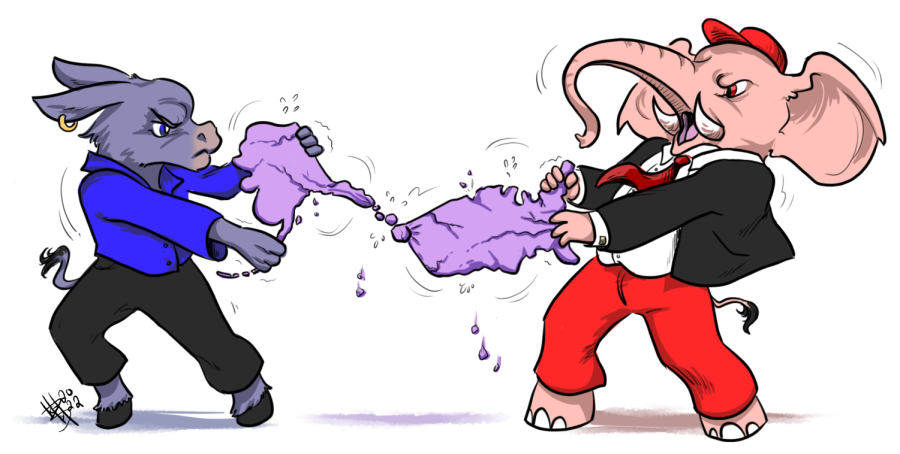Misa: Two sides in America, and neither is winning
United States political parties, depicted with a donkey and elephant for the Democratic and Republican parties respectively, fight over the nation. “The larger polarization of politics is being reflected in the court right now,” said Oregon State University Associate Professor of Political Science Sarah Henderson.
August 1, 2022
I think it’s fair to say that regardless of your political views, the state of the United States government at this moment in time is deeply flawed. Now why is that?
The many issues plaguing this country are in part caused by the two party system that the U.S. has maintained for almost as long as the U.S. has existed. As it stands, there are two major political parties in the U.S., and it has been those two for almost two centuries too long.
There has been an ever deepening divide between the two ideologies of the parties, which has led to the ever increasing polarization of the nation. Somewhere along the lines, we stopped thinking about the different parties as being people with different opinions or maybe different perspectives. Somewhere along those lines, shades of gray became black and white; right and wrong; us and them.
I don’t know about you all, but I sincerely hated the two options we had for the 2020 election. Rather than having an election that came down to the candidates with the two best visions for the future of our own country, we were given two candidates that only got to where they were because they were the safe options for their respective parties.
“The larger polarization of politics is being reflected in the court right now,” said Oregon State University Associate Professor of Political Science Sarah Henderson. “But explaining the courts’ decisions is multicausal.”
While the two party system is only a small part of the problem faced by the U.S., it is still an important one. Which is something that Henderson agrees with.
“The two party element plays into the current situation in that currently our two party system, instead of encouraging party leaders to capture the median voter (encouraging centrism) has become more polarized, and are supported by more polarized bases,” Henderson said.
As a side effect of the polarized bases, American politics is virtually going to always be limited in its expression of what the American people want. We see this most prevalently with the limitation of political figures from being able to disagree with their own party’s ideologies.
In the case of President Biden, who sup- ported the Hyde Amendment that restricted government funding of abortions, it meant he had to choose between maintaining his stance or changing it to keep his voter base.
“If you don’t change your stance, then you lose your base. You lose the activists who will vote on that issue,” said OSU Professor of Political Science Rorie Solberg. “If you do change your stance, then you’re a flip-flopper.”’
Whether or not it was because Biden had a change of heart or not, Biden still changed his stance on the Hyde Amendment, only days after his campaign had reaffirmed his stance on the amendment.
The problem of party loyalty is not something that can be fixed by moving past the two party system to one such as the proportional representation found in countries such as Germany, Sweden and Ukraine according to Henderson. However, it is still a large step in the right direction.
However the change would definitely help dampen some of the worst consequences of the two party system, including that of gridlock and an inability to compromise on the most mundane legislation in congress.
The vast majority of both Democrats and Republicans are much more centrist than they are left or rightist.
Unfortunately for them, in order to get even just a fraction of their voice to be heard, they have to spew out the other sentiments in their party that they may not necessarily agree with.
All it takes in the US is a third moderate party to start bridging the gap between the left and the right. Sure that may sound a bit optimistic, but why is it that we have decided to see each other as enemies?
Why do we allow two parties that do not care about our well being dictate whether or not we get to call each other friends? It’s past time that we start finding the stuff we agree on and start trying to compromise on the things we don’t.

















































































![Newspaper clipping from February 25, 1970 in the Daily Barometer showing an article written by Bob Allen, past Barometer Editor. This article was written to spotlight both the student body’s lack of participation with student government at the time in conjunction with their class representatives response. [It’s important to note ASOSU was not structured identically to today’s standards, likely having a president on behalf of each class work together as one entity as opposed to one president representing all classes.]](https://dailybaro.orangemedianetwork.com/wp-content/uploads/2025/03/Screenshot-2025-03-12-1.00.42-PM-e1741811160853.png)
























